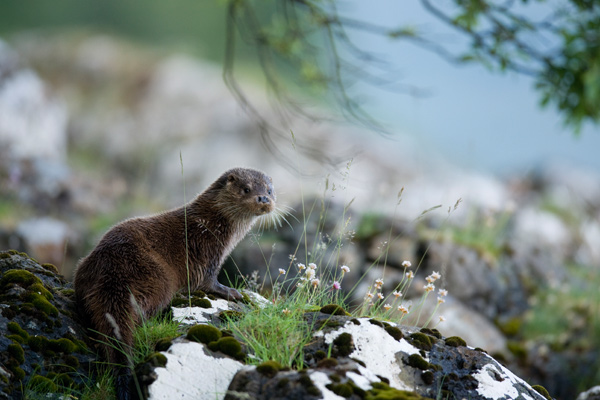I was sheltering in the dunes on a Hebridean beach, reading this book, when I happened to glance up and see an otter galumphing out of the machair and down onto the sand, 20 yards off. Long, hump-backed and shiny, it was the first wild otter I had ever seen. Such is the talismanic power of this book that I suppose Miriam Darlington must have summoned him for me. Here she is, evoking her own first encounter:
I get a flash of the bristling vibrissae, the otter’s extravagant whiskers, and in a split second he catches my scent. He runs and makes a direct gallop for the shoreline. He moves quickly, but with the lumbering gait that, I learn later, otters always have on land. His body arches into a small hummock as he runs, but when he disappears back into the water, he does so without a sound.
Quite unlike me. I merely stood up in amazement, pointed, and shouted ‘Otter!’ Everyone stared, and the dog heard too.
You do not see them, as a rule. By day they lie curled up in their holt, which might be a tangle of roots, a lair of twisted grasses or a badger hole, slinking out to fish mostly in the dark. In rivers they are impossibly lithe and swift, dissolving into a streak of bubbles, or a ripple on the water’s surface. An ordinary otter’s body is covered in 400 million hairs, trapping air for warmth and helping it move like a soft calligraphic brush. A dog otter weighs 25 lbs and is twice the size and ten times as heavy as a mink, but otters camouflage their movements so well that they can seem to be a part of the water they inhabit, a fact that endears them to poets as well as ecologists.
Miriam Darlington is a poet, the granddaughter of the pugnacious evolutionary biologist Cyril Darlington, who has been fascinated by this elusive spirit of the wild water, ever since, aged 11, she was given an otter skull to hold. ‘The strangeness of cool bone filled my palm; sharp canines, flattened crown, broad eye sockets.’ Otter Country is the distillation of her wanderings through the various otter districts of Britain, a sharply observed and lyrically written meditation on the animal that has ‘become an icon of nature conservation. In our minds it is cuddly and playful,’ she writes, ‘but in reality it lives the harsh life of a top predator. It represents the worst and the best of what we humans can achieve in our relationship with the natural world.’
The relationship is marked, at best, by a fierce intensity, especially among the poets. As long ago as 1575 George Turberville pleaded the cause in ‘The Otter’s Oration’, when otters had lately been classed as vermin and earmarked for annihilation.
. . . all Adam’s seede…
Do daily seeke our names for to distayne,
With slanderous blotte, for which we beastes be slayne.
Henry Williamson moved to Devon for the otter; Ted Hughes followed Williamson, describing the otter’s ‘Underwater eyes, an eel’s oil of water body … crying to the old shape of a starlit land.’ Tarka the Otter struck Hughes ‘as something of a holy book, a soul book, written with the life-blood of an unusual poet’. Both Gavin Maxwell and Williamson experienced tragedy with otters: for Williamson, the loss of his otter, caught in a rabbit trap, drove him to a creative frenzy that became the story of Tarka. Maxwell’s otter Mij was fatally released by the poet Kathleeen Raine, ‘that bloody witch’, from whose verses Maxwell lifted the phrase ‘Ring of Bright Water’. Raine herself wept ‘streaming rivers of tears that would not stop’.
Darlington’s encounters with conservationists and biologists suggests that the passion for otters is not confined to the poets. In the Highlands, the wilds of Dartmoor, the Somerset Levels, the Cheviots, the Lake District, her investigation of each habitat is as much an enquiry into the health of the landscape, and water’s part in it, as into the otter itself. ‘A lattice of water feeds the peat moors of the Levels,’ she writes.
Some of this area has been named the Avalon Marsh, as if everything is charged with something we have forgotten or lost, as if water and forgetfulness have mingled. For most of us in Britain, water goes obediently through pipes….
Otters have been protected since 1978, but Darlington acknowledges that the hunstmen at least maintained a relationship with otters. Nowadays the first we know about their presence is when they start turning up as road kill.
Some editorial glitches aside, Otter Country, like a free-flowing stream, invites leisurely dipping. On the beach, our dog raced over the sand, followed by the children. The otter responded rather slowly. The dog bowled it over, and danced about. Just before the otter disappeared into the marram grass it turned and bared its wicked teeth.






Comments